
NEW YORK – The John Jay College of Criminal Justice’s Center on Media, Crime and Justice is holding a two-day conference for journalists on its campus in New York Monday and Tuesday. JJIE/Youth Today’s John Fleming and Clay Duda are attending the conference and will be reporting some highlights throughout. While the conference, Kids Behind Bars, Where’s the Justice in America’s Juvenile Justice System?, is primarily meant for journalists, many of the topics will be of interest not only to those in the field, but the general public as well. Speakers on Monday include: Mark Soler, executive director of the Center for Children’s Law & Policy; Vincent Schiraldi, commissioner of New York City’s Department of Probation; Ricardo Martinez, co-director, Padres & Jovenes Unidos and David Utter, director of policy, the Florida office of the Southern Poverty Law Center. Gail Garinger, a former juvenile court judge, who is now the Child Advocate of Massachusetts’ Office of the Child Advocate, will deliver the keynote address.









